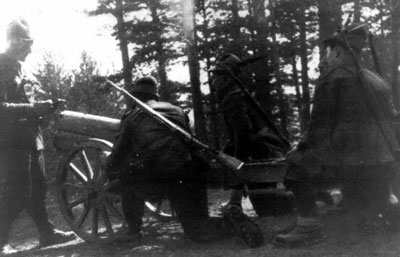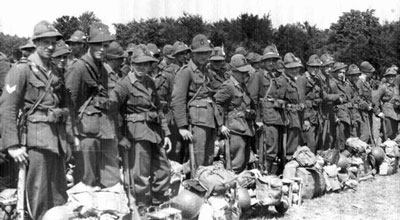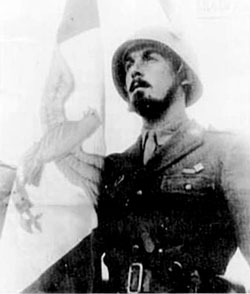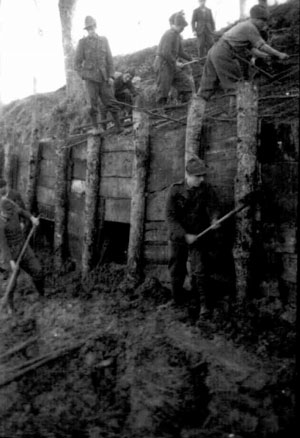|
|

|
Monterosa Alpini Division
Return to RSI Introduction...
Named after one of the most famous ski Alpini battalions, which performed very well during Greek Campaign, the Monterosa Division was officially raised on 1 January 1944 in Pavia and was immediately sent to Germany, accordingly to the Rastemburg agreement. Only about a sixth (16%) of the Monterosa troops were former Italian Army (Regio Esercito, Royal Army) soldiers captured by the Germans after the 8 September 1943 armistice, and released as they swore allegiance to Mussolini’s Republic. The remainder were new draftees (1924-25 contingent youth).
The training in the German training grounds of Munzingen and Heuberg began in December 1943 and ended in July 1944 The Division was then sent to the Italian theatre.
|
Although the Monterosa officially was a Mountain (Alpini) troop unit, the troops never received mountain warfare training. In fact the Monterosa Division’s training schedule was "abridged" and less thorough than that of a regular German Division. Nonetheless, it was intensive, tough, realistic and demanding, after the best German tradition. However, cohesion within the Division was not uniformly good.
When Mussolini reviewed it before their departure to the front, Monterosa (under General Mario Carloni, a gallant and skilled officer, formerly commander of 6th Bersaglieri Regiment on the Eastern Front) was at full strength, well trained, reasonably well equipped and eager for fighting. But for a number of reasons, it would eventually fall short of expectations.
|
 |
Organization and Equipment
The Monterosa Division had two infantry regiments (1st Alpini, Col. A. Farinacci commander; 2nd Alpini, Col. Manfredini commander) and an artillery regiment (1st, Lt. Col. Binda commander), plus support and service units, with 20,000 troops (including 30 women auxiliaries), 1500 automatic rifles, 1000 machine-guns (mostly German MG 42s), 50 80 mm mortars, 36 75/13 howitzers, 12 105/17 howitzers, 3 75/27 field guns, 21 75mm infantry guns, 12 75mm PAK 40 anti-tank guns, 36 Panzerschreck anti-tank rocket launchers, 144 Panzerfaust anti-tank weapons, 12 20mm anti-aircraft guns, 24 flamethrowers, and 6 armoured cars. |
 |
 |
All in all, on paper it was probably the most powerful Italian infantry division ever.
The basic infantry weapon was the German Mauser K98 rifle, but G41 self-loading (semi-automatic) rifles were also supplied. The artillery (with the exception of the German PaK guns) was obsolete, though still effective in a mountain environment.
|
|
Employment and History
The original destination, the western Alps front, was changed during the return to Italy. The increasing number of Allied ships in North Africa, Corsica and Tirrenian harbours at the end of July was a signal, in OKW opinion, of another imminent Allied seaborne landing. Not knowing the Allies objective (which in fact was southern France) and weary of another outflanking landing such as Anzio an army was formed as a counter. From July to October 1944, the Monterosa was part of the so-called "Liguria Army" (north-western Italy) under Marshal Graziani.
The division, other than defensive preparations for the possible Allied landing, were also charged with the protection communication lines between the Liguria and the Po plain.
They protected supply lines and were engaged in anti-partisan duties. They were therefore engaged in a number of actions, coordinated between several units, against the partisans.
|
 |
On 15 August 1944 the guessing over the Allied landing was over as Anglo-American landed in southern France. With the immediate threat to the Ligurian coast over for the moment it was decided to employ a greater part of the division in the defence of the Gothic Line.
|
 |
While the division was employed in static and anti-partisan duties the morale of the troops rapidly dropped.
Desertions became commonplace and became a painful thorn in the side of the Republican cause. One entire replacement battalion, the Vestone, simply melted away. Civil war even looked likely in 1944; the Germans mistrusted the Republican troops, and often refused to give them much needed weapons and equipment, most Italian civilians ignored or despised them, the partisans ambushed them from all sides and murders in cold blood were not unknown. These reasons led to many Republican soldiers deserting. However, among the Monterosa units sent to the Gothic Line in October the desertion rate dropped decidedly and desertions were no longer a major problem.
Italian and foreign writers alike have always stressed the high Republican desertion rate, but it’s worth remembering that also among the pro-Allied Italian troops the deserters were very numerous until late 1944. However units like the powerful, well equipped, trained, and victorious British 56th Infantry Division had 350 deserters in two weeks after the battle of Sangro River; and that the British 46th Infantry Division had 1059 deserters during the Italian campaign, that is to say, 1 out of 14 men.
Nearly a half of the Monterosa Division was sent to the Garfagnana front, and formed the "Fretter-Pico Group" together with the German 148th Infantry Division. It successfully took part in Operation Wintergewitter, while the other half of the Division kept on carrying out its garrison duties.
|
Monterosa Order of Battle, Autumn 1944
|
| • Division Headquarter |
(Commanders:
Col. Umberto Manfredin, January through March 1944;
Gen. Goffredo Ricci, March through July 1944;
Gen. Mario Carloni, July 1944 through February 1945;
Col. Giorgio Milazzo, until April 28, 1945).
1st Antitank Company
1st Engineer Battalion
1st Signal Battalion
1st Transport Battalion
101st "Ivrea" Replacement Battalion
2nd "Vestone" Replacement Battalion
"Saluzzo" Operational Battalion |
| • DVK 183 |
(Deutsche Verbindungs Kommando, German Liaison Unit) (General Egbert Picker) |
| • "Cadelo" Divisional Recon Group |
(Lieutenant Colonel Andolfato):
HQ;
3 Cyclist Bersaglieri Troops;
3 75/27 field guns;
3 20 mm AA guns;
4 armored cars;
6 vehicles;
20 trucks;
12 motorcycles. |
| • 1st (7th) Alpini Regiment: |
HQ Company;
Light Column;
101st Cacciatori Carri (Tank Hunters) Company;
17th Company;
"Aosta", "Bassano", "Intra" Alpini Infantry Battalions |
• 2nd (8th) Alpini Regiment:
|
HQ Company;
Light Column; 102nd Tank Hunters Company;
"Brescia", "Morbegno", "Tirano" Alpini Infantry Battalions. |
| • Artillery Regiment: |
4 Groups (=Battalions):
1 Group with horse-drawn 100/17 field guns,
3 Groups with 75/13 mountain guns transported by pack mules. |
Each infantry battalion was composed of 3 riflemen companies (220 men each) and one heavy weapons company (300 men), plus a Headquarters company (service troops). Each artillery battery numbered 300-350 men.
Ammunition was in fairly good supply. Instead, only a half of the TO&E’s (Table of Organization and Equipment) 5,000 horses and mules were available, and only one third of the vehicles.
Operation Wintergewitter... |
 |
Last Updated On Tuesday, June 19, 2007 by Wayne at Battlefront
|
|